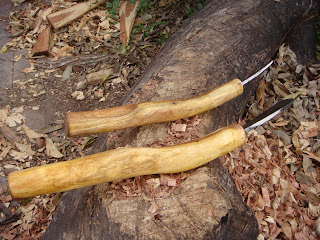I’ve mentioned that many of the woods found in the Southwestern parts of The United States are nearly as hard as rock. The woods seem forged and compressed in much the same ways that various loose molecules were gathered then rammed into monoliths of granite, basalt and quartz. The woods are hard to work and unforgiving to those who insist on using brute strength to reshape them. Axing Southwestern woods, for example, oftentimes turns a young man’s elbows and shoulders into scraps of arthritic bone. And carrying the wood to build an Indian jacal (ha-kal) or using it to make yokes or horse corrals will dislodge lower vertebrae and make young vaqueros into old men by the age of forty-five. Ranch hands and woods roamers either learn to work smart or they grow old and tired quickly. Over the years I’ve seen just about every sort of contraption used to trick the wood into relinquishing its pieces. In some of the ejidos (eh-hee-dos) or agrarian villages of Mexico and on ranches in the Brushlands and on into the desert regions I’ve seen workers chip away at hardwoods using everything from sharpened screwdrivers to burning coals.
Below are photos of a couple of mega-chisels I recently made to coax shavings out of mesquite bowls and other woodcraft projects. The chisels were made from an old file. The file was 16-inches long and a quarter inch thick. When new it had a fine cross-grid diamond pattern that was probably used as a blacksmith’s finishing tool. The larger chisel measures slightly over 1½ inches across the blade and is 16 ½ inches in overall length. The smaller mega-chisel measures 11/8 inches across the blade and is 15 inches overall.
The large mega-chisel’s blade juts out 4 ¼ inches from the handle and the smaller mega-chisel’s blade extends 3 ¼ inches. I used metal washers on both chisels as stops to keep the steel from drilling into the handle. Both chisels were reinforced with an amalgam of 30-minute epoxy glue and ultra-fine wood dust I keep handy for gluing.
Another angle showing how I curved the handles in order to accommodate the shaving action I intended to utilize when carving bowls. The upswept handles enable me to contour the bowl simply by manipulating the handle upwards or downwards.
This provides some perspective of the size of the two mega-chisels when compared to a Swiss Army Knife and two Flexcut™ chisels that I also hafted for making spoons from dry wood.
The mega-chisels allow me to use a rubber mallet to tap out wood creating either deep cuts or paper thin shavings. Because I’m using the inertia generated through the mallet into the chisel I can regulate the force used in my woodworking and I can work for hours without experiencing any sort of fatigue. It’s quiet work without the manic sounds of electric power tools or the incessant and obnoxious clouds of wood dust. As long as I’ve got something to immobilize the wood like a strap or vise then I can work sitting in the shade of a tree—a cup of coffee brewing on the campfire and my dog Oy glancing at me now and then to keep track of my progress.



No comments:
Post a Comment